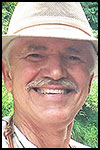Mike Full: Through the mists of time
Almost anyone who knows me will tell you my viewpoints can be a bit eccentric.
Looking out across the Yamhill River Valley, most folks see combines harvesting wheat and hear harvesters moving through fields of corn. I, however, envision herds of Columbian mammoths grazing peacefully and hear American mastodon trumpeting in the background.
I gaze back through the mists of time to discover Highway 18 no longer a busy thoroughfare carrying people to and from work. It’s a trackway over which vast herds of Ice Age bison migrate up and down the valley.
The lumbering giant ground sloth no longer appears strange along the South Yamhill River. He seems right at home.
Welcome to my world!
Fifty thousand years ago, the Willamette Valley of the late Pleistocene was a wondrous place, both familiar and exotic at the same time.
Many of its trees, shrubs, grasses and flowers would be easily recognizable to us, and much of its wildlife quite ordinary. Deer, elk, horse and beaver were all very much at home in the valley.
Other animals of that time can be found only among the extinct. We know them simply from their fossils.
The valley’s sediments and fossil record tell us the late Pleistocene was a period of great local change. The climate was warming, causing massive ice sheets to the north to recede.
Our Yamhill River had yet to carve today’s deep channel. It wandered back and forth across the valley floor, leaving behind sediments that fix its track. These can be dated to tell us when the river was flowing where.
The river ran over and through blue clay, the volcanic legacy of the Boring ash falls, which ended a mere 50,000 years ago.
Over this lies layer upon layer of sediment from successive Ice Age floods. They roared down the Columbia River and backed up in the Willamette Valley all the way to Eugene.
The Yamhill River Valley has yielded an abundance of fossil evidence, dating from more than 50,000 years ago through the great Ice Age extinction. Along its banks, and on its bottom, we find the remains of those Columbian mammoths and American mastodons.
They were both giants in their own right. The Columbian mammoth was perhaps the largest elephant ever, with a bull standing nearly 14 feet at the shoulder and weighing as much as a Tyrannosaur.
Monstrous next to today’s buffalo descendant, the Ice Age bison could stand eight feet at the shoulder. These bison shared the valley with horses similar to those gracing pastures today, and a cousin more akin to a zebra.
Weirdest of all, but common, was the giant ground sloth, arriving after a long evolutionary trek from South America. Camels and llamas were scarcer, but also ranged the valley floor.
Oregon, of course, is known as “The Beaver State.” Fittingly, we discovered in 2017 that Castoroides, the giant Ice Age beaver, had also made its home here.
This beaver grew to the size of a black bear. Never before documented west of the Continental Divide, we now have fossil records from two individuals.
We know all this in large part due to the uniqueness of McMinnville.
In the mid-1960s, the McMinnville Kiwanis Club developed a park allowing access to the South Yamhill River. And suddenly, as a young boy, my world widened.
Thanks to Kiwanis Marine Park, I was able to spend every spare minute rowing up and down that muddy old river. I explored, fished, swam and, of course, looked for fossils.
Later, as a brand new member of the McMinnville police force, I returned to the Yamhill River on weekends. And before long, I found a fossilized Columbian mammoth eroding out of the bank on city property.
Out of that experience grew my lifelong love, the Yamhill River Pleistocene Project.
I don’t think it could have been done anywhere else, and I mean that in all sincerity. Local folks recognized the significance of the site and together allowed its exploration.
City Manager Kent Taylor granted unfettered access to me and all the volunteers I could muster. The city and county loaned us equipment for weekend use.
McMinnville Water & Light, Burch Concrete, Mac Rental and local farmers all donated time on equipment. The police department facilitated site access and provided security.
And the people!
Marvin the businessman, Larry the police officer, Mack the state corrections officer, Lee the plant manager, Roger the truck driver. They appeared with shovels, boots, gloves and, most of all, heart.
Every fossil is important, whether discovered weathering out of the bank or resting in bottom sediment. Each is tagged, GPS marked and data recorded.
Later, each is carefully measured, photographed and logged into a single database. Excavations are surveyed, gridded and meticulously processed, always under the watchful eye of an on-site scientist or direction from a more distant authority.
Everything we find remains in the public domain. The data and specimens are destined for a public repository, which will ensure they remain accessible long after I am too old to continue my adventures.
The fossils constitute a public trust. The city, the county, local property owners and the people of our community have bought into this for 30 years, and we have no intention to see it change. Our stewardship is rooted in integrity, honesty and transparency.
Community outreach and education has become an increasing focus of our river endeavors over the years.
As a result, a McMinnville High School class unearthed Oregon’s first-known Mammoth tracks. Polk County 4-H students found fossils along the river and followed up with public presentations.
Sherwood Middle School students learned how to cast and finish extremely realistic fossil replicas. Their work now graces the Cabela’s store and Tualatin Public Library.
We’ve also worked with five regional institutes, colleges or universities, including Linfield. In 2018, our project involved more than 2,000 Willamette Valley students and residents.
Last summer, I was fortunate enough to work with a pair of Linfield interns, Bronwyn Boyd and Sarah Schmidt. They epitomized all the best I had come to expect working with students.
I couldn’t have been happier with the intensity Bronwyn showed on the hunt for fossils, or Sarah’s all-encompassing smile with each find. They recorded data and took thousands of measurements, always with such focus.
They threw themselves into the project, often showing up when they didn’t have to, and always with the interest and enthusiasm of youth. I hope Linfield feels as proud of them as I do.
No, it couldn’t have been done anywhere else.
McMinnville was a wondrous place during the Pleistocene. Growing up in today’s McMinnville was an adventure. Serving the community as a police officer, and forming partnerships on the side to establish the Yamhill River Pleistocene Project has been an honor.
We should hold on to the values that made this place, some 50,000 thousand years in the making, so special. For what it’s worth, anyway, that’s my viewpoint!









Comments